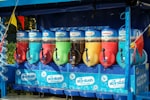Ever since the lockout in 2012, the NHL has been pushing hard for growth. They set a record in Canada for the rights deal to Rogers for Canadian national TV coverage, but they won’t do that in America when the NBC deal is renewed in 2021. However, they do want that deal to be a lot larger than it is now. Expansion teams have fuelled growth, and ticket sales in some of the worst markets have risen. The NHL has been projecting optimistic revenue growth for years that has been, at worst, a little too sunny an outlook, but was never wholly unrealistic.
That’s all changed.
The 2019-2020 actual revenue is going to fall far short of the projection that was used to set a salary cap of $81.5 million per team. Next year’s revenue may well fall even further, and yet the salary cap is frozen at the same amount.
This is a brand new world where debt is growing, not revenue.
The Past
By 2017-2018, the NHL had grown its revenue to just under $5 billion (Forbes - January, 2019). The projected revenue for this season was approximately that $5 billion, and had been built on growth projections of a slightly more modest amount than they’d been using in the past.
Related
Oops: Gary Bettman and the NHL guessed really wrong on last season’s revenue
Of that $5 billion, $200 million per year comes in from NBC for national TV rights, and the Rogers deal pays in something around $500 million CAD$ (the deal pays a gradually increasing payment each year through to 2026).
There are other TV rights deals in both countries for local coverage, and the NHL has its own streaming service and international broadcasts. Revenue also comes in from various forms of advertising and sponsorship and merchandise sales. But the widely accepted estimate is that the NHL makes at least 50% of its revenue from ticket sales and other things fans spend money on in the arenas, and that the NHL relies on fans in the stands more than any of the other big-four professional North American team sports.
This Season
The big number bandied about this summer was $1 billion. That’s the amount of revenue the NHL would have lost without any return to play. With the return to play, they will hope to carve a chunk back out of that loss, but there is no possible way that the NHL can earn close to its projected revenue for this season without ticket and concession sales for the playoffs and with all the massive expense of playing in hub cities.
When the actual revenue totals are understood and agreed upon next year, they will be split in half to account for the owners’ share and the players’ share. We know now there will not be enough in the players’ share to cover all of the salary money that has already been paid out. The amount sitting in the escrow pool, topped up to around 20% when the players voluntarily threw in their last paycheques in the spring, will be paid out in full to the owners within 15 days.
That’s what the escrow pool is for. It’s the buffer that holds some money out of circulation until the split can be finalized. In every season before now some of that money has been doled out to the players. Sometimes most of it. This season the reverse is true.
The players are in debt.
The NHLPA and the NHL entered into negotiation on a CBA extension knowing these things were true: the players have been paid more than 50% of the total revenue, so they owe the owners some money back, and next year’s revenue might be even lower.
The Future
The process of using escrow as the buffer to allow for a range of possible real revenue results has always included the potential for it to end up with the players in the red. It hasn’t ever happened, largely because the revenue and escrow percentage estimates have to be really wrong for it to occur.
Until now.
The 2020 CBA extension decouples the future salary cap amounts from reality. It further decouples the escrow percentages from reality, and embarks upon a series of seasons where the base assumptions that govern how much will be sitting in the escrow pool are based on a fantasy. The new salary cap is flat, but based on last season’s real numbers, not the current ones. There is a mechanism to have the salary cap rise if real revenues bounce back quickly, all while escrow will decline every year.
These are the actual numbers:
Salary Cap
2020-21: $81.5 million
The cap will remain at that amount until HRR returns to between $3.3 and $4.8 billion. If HRR goes up, then a prorated amount between $81.5 and $82.5 will become the next salary cap. Once HRR tops $4.8 billion, the salary cap will rise by $1 million per year until the escrow debt is all cleared.
There’s two exceptions to all of that. If things get a lot better, they can agree to step the cap up in the year before they start using the new formula to calculate it. They can also discuss lowering it if HRR drops.
Escrow
- 2020-21: 20%
- 2021-22: 14% - 18% based on revenue estimates for the previous year
- 2022-23: 10%
- 2023-24, 2024-25, 2025-26: 6%/
This will work swimmingly if the NHL revenues rebound from the 2019 through 2021 low levels to something like that former $5 billion a year. If they don’t, the players will go deeper and deeper into debt to the owners. This CBA is a very optimistic bet by the players with a lot of hedging built in to protect the owners if that optimism is misplaced.
Everyone knows the score here, and has accepted the potential for a huge escrow debt as part of the mass financial fantasy they’re enacting. They’ve built in a way to make the players’ debt recoverable, while maintaining the current contract economy where $11 million a year on paper turns into actual dollars paid that grow closer to that figure as time goes by.
The bottom line is: The owners won’t be moved off the 50-50 split that underlies the entire system. They could have dealt with this (possibly) temporary period where the only thing growing is debt by allowing that split to slide in favour of the players. Which is a popular concept with a lot of fans, and seems fair as long as you think the owners’ share really is used up by gold plating.
The NHL intends to play a full season next year, but they can’t know now how much of that season can be played in front of fans, and they can’t begin to guess if people will go just because they can go. If revenues don’t rebound and the escrow debt grows, the process for handling that is an automatic extension of the 2020 CBA for one additional year with a 9% escrow cap and salary cap the same as in 2025-2026. The criteria to trigger the extension is escrow debt between $125 million and $250 million. If the debt has ballooned up over the $250 million level, some reduction in the salary cap or increase in escrow will have to take place and be negotiated into the new CBA at that time.
When you look at the very long timeline both sides are projecting to work through fantasy numbers and back to real ones where actual revenue is considered when setting the salary cap, it’s clear that players now could incur a debt that players of the future will have to pay part of.
If revenues do rebound and the debt gets paid up, a new method of calculating a salary cap will be used that uses the most recent actual HRR number (which will be two seasons old each time) and the previous season’s projected revenue. This formula might keep those overly optimistic projections of the last eight years from happening again.
For the first year of the new 2020 CBA, the players have also agreed to defer 10% of their salary and signing bonuses separately from the 20% escrow. It’s guaranteed to be paid back in instalments over three years, and the point of this extra hit on the players is to make the day-to-day operation of teams that won’t be earning any money for some time a little less difficult.
If the projected $1 billion loss in revenue this season comes to pass, that’s an average of $32 million per team. That might only buy you three forwards on the Leafs, but it will buy you a lot more than three janitors, scouts, or even coaches for an NHL team. It’s a lot of money to try to make up for on teams that have debts instead of reserves. And if next year’s income is less than $5 billion by that much again, the problem will start to snowball.
The optimistic take on this is that as soon as fans can be back in the stands in all arenas, and all the revenue streams start up again, the NBC deal will double, another expansion franchise can be sought, and everything is golden again. This could just be a blip. The optimist is betting on “as soon as” being very soon. But the NHL owners and players built in provisions for “as soon as” coming a lot further into the future than we all want.
A pessimist take is that the real losers here are the players who couldn’t use their position of maximum leverage to get the owners to change the revenue split. What they did instead is push the pain off onto players who haven’t even signed their ELCs yet. But then making the youngest players subsidize the oldest players’ salaries is built into the system of the NHL CBA too. It’s just another hockey tradition.



